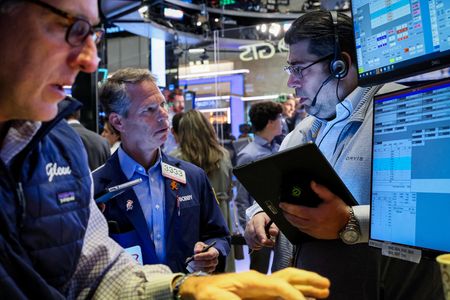By Sinéad Carew, Sruthi Shankar and Johann M Cherian
(Reuters) – U.S. stock indexes rebounded on Tuesday from a recent losing streak as upbeat economic data soothed investor worries about an imminent recession triggered by the Federal Reserve’s aggressive interest rate hikes.
Separate reports showed new orders for key U.S.-manufactured capital goods unexpectedly rose in May, and sales of new single-family homes surged in the same month, while U.S. consumer confidence increased to a near 1-1/2 year high in June.
The data gave investors a reason to buy back into stocks after a “pretty vicious correction” in the last several sessions, said Mark Luschini, chief investment strategist at Janney Montgomery Scott in Philadelphia.
“What we have today is this series of economic releases that on balance fit this setting of an economy that continues to be in an expansionary mode, without at the same time suggesting there’s any condition that’s running too hot.”
And just days before the second quarter ends, Luschini said it was notable that some the top sector performers on Tuesday, such as consumer discretionary and technology, were also the market’s biggest gainers on a year-to-date basis.
While the economic data was encouraging, Rhys Williams, chief strategist at Spouting Rock Asset Management, said the market was likely helped by so-called window-dressing, when fund managers add outperforming assets to their portfolio for their quarter-end statements.
“You’d a bad week in the stock market last week and a bad day on Monday. It’s just a bit of recovery,” said Williams. “There could be some quarter-end window-dressing too as we get close to the end of the quarter.”
The blue-chip Dow Jones Industrial Average snapped a six-day losing streak on Tuesday while the tech-heavy Nasdaq Composite was eyeing its best first-half performance in 40 years and the S&P 500 advanced after falling in five of the last six sessions.
The Dow Jones Industrial Average rose 212.03 points, or 0.63%, to 33,926.74; the S&P 500 gained 49.59 points, or 1.15%, at 4,378.41; and the Nasdaq Composite added 219.90 points, or 1.65%, at 13,555.67.
The signs of U.S. economic resilience also boosted the Dow Transports index, which closed up 2.7% and the small-cap Russell 2000 index, which advanced 1.5%.
And the PHLX Housing index closed up 2.99% after hitting an all-time high on Tuesday.
Traders were pricing in a roughly 77% chance the Fed will raise interest rates by 25 bps to the 5.25%-5.50% range in its July meeting, according to CME Group’s Fedwatch tool, up from 74.4% a day earlier.
More economic data is expected this week, including a key inflation measure, as well as Fed Chair Jerome Powell’s speech at the European Central Bank Forum in Sintra, Portugal, which could provide cues on the path of interest rates.
Powell’s hawkish comments last week stalled a U.S. stock rally that had pushed the S&P 500 and Nasdaq to an over one-year high and the Dow to a six-month peak.
Despite recent market weakness, a growth stocks rally, an upbeat earnings season and hopes of the Fed ending its monetary tightening soon have set the main indexes on course for quarterly gains.
Market heavyweights Microsoft Corp and Apple Inc were among the biggest boosts to the S&P 500 during the session, along with Amazon.com Inc, Tesla Inc and Nvidia Corp.
Meta Platforms Inc shares rose 3% after Citigroup raised its price target on the stock.
Snowflake climbed 4.2% after the cloud data analytics company announced a partnership with Nvidia to allow customers to build artificial intelligence models using their own data.
Walgreens Boots Alliance shares sank 9.3% as the pharmacy chain cut its annual profit forecast on lower demand for COVID-19 tests and vaccines.
Other drugstore chains, including CVS Health Corp and Rite Aid Corp, also fell.
Lordstown Motors Corp shares slumped 17.2% after the U.S. electric truck manufacturer filed for bankruptcy protection and put itself up for sale.
Advancing issues outnumbered decliners on the NYSE by a 2.55-to-1 ratio; on Nasdaq, a 1.54-to-1 ratio favored advancers.
The S&P 500 posted 46 new 52-week highs and one new low; the Nasdaq Composite recorded 64 new highs and 150 new lows.
On U.S. exchanges 10.16 billion shares changed hands compared with the 11.63 billion average for the last 20 sessions.
(Reporting by Sinéad Carew in New York, Sruthi Shankar, Johann M Cherian in Bengaluru and Terence Gabriel in New York; Editing by Shinjini Ganguli and Richard Chang)





